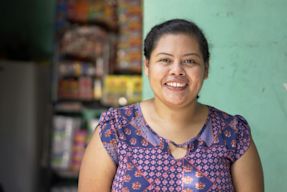Each year, the World Economic Forum releases its Global Gender Gap Report, ranking countries by gender equality and tracking the progress of gender equality around the world. In 2022, the WEF processed data from 146 countries to find where in the world gender equality is the highest—and where women still experience fundamental obstacles to equal opportunity, political representation and financial inclusion.
What are the best countries for gender equality?
Countries where gender equality is the highest are located in varying regions around the globe. Nordic countries—Iceland, Finland, Norway, and Sweden—top the list, thanks to their gender equitable labor policies, healthcare access, and representation in government and leadership positions. Regionally, however, North America leads the world in gender parity with an overall 76.9 percent gender gap score*, with Europe following at a close second with an average 76.6 percent. The region of Latin America and the Caribbean ranks third, bridging 72.6 percent of its gender gap. Though no country has achieved total gender equality, Iceland remains in the number one position with a gender gap score of 90.8 percent. Three countries in the Southern Hemisphere—New Zealand, Rwanda, and Namibia—share high scores for wage equality and high participation of women in the workforce. Nicaragua moved up five places this year with increases in educational access and parity in parliamentary positions.
In which countries around the world is gender equality the highest?
Top 10 countries ranked by gender equality
Iceland 90.8%
Finland 86%
Norway 84.5%
New Zealand 84.1%
Sweden 82.2%
Rwanda 81.1%
Nicaragua 81.%
Namibia 80.7%
Ireland 80.4%
Germany 80.1%
Read more: 27 actionable ways to promote gender equality
*What is a gender gap score?
Countries are ranked on the basis of each country’s gender gap score. Using data collected from surveys and validated sources, the WEF derives each score by measuring gender-based gaps across four pillars:
Economic participation and opportunity
Educational attainment
Health and survival
Political empowerment
Each country receives a ranking between 0% (the lowest possible gender equality) and 100% (the highest possible gender equality), which provides a view of individual economies as well as marks the distance towards which the gender gap has been closed. The goal of the report is to “offer a consistent annual metric for the assessment of progress over time,” allowing leaders and policymakers to analyze gender parity by country and region and focus on solutions.

Donate to Kiva today to help decrease the gap for gender equality
In which part of the world is gender inequality the highest?
According to the WEF report, many countries with the lowest gender gap scores are located in the macroregions of Middle East and North Africa and Sub-Saharan Africa. Political, economic, and educational opportunities remain limited in these countries for women and girls, who also face greater risks to their health and safety than men.
10 countries with least gender equality
Afghanistan 43.5%
Pakistan 56.4%
Democratic Republic of Congo 57.5%
Iran 57.6%
Chad 57.9%
Mali 60.1%
Algeria 60.2%
Oman 60.9%
Benin 61.2%
Qatar 61.7%
Global trends in gender inequality
Dialing into the four pillars mentioned above, the WEF report examines gender gaps through additional global workforce data from individual countries. These additional metrics provide a picture of gender inequality in the workforce worldwide, and show that women continue to struggle with the effects of climate change, geopolitical conflict, and societal expectations. These subcategories include:
Labor market recovery: After the pandemic, unemployment rates remain higher for women.
Care work: Women continue to shoulder the brunt of childrearing and unpaid care work.
Industry leadership: While women in leadership positions have increased over time, gender equality across industries is far from realized.
Political representation: Progress continues on this front for gender equality, with the global average of women in ministerial positions nearly doubling since 2006.
Wealth accumulation: Unequal access to banking and financial services plus wage inequality continue to create a disadvantage for women in regards to wealth.
Lifelong education and skill prioritization: Women are still overrepresented in educational and social welfare degrees and underrepresented in engineering and other STEM-related fields, though online classes are helping bridge this gender gap.
Stress levels: Women reported stress at rates 4 percent higher than men, adding to a growing global mental health crisis that disproportionately affects women.
Is gender equality making progress around the world?

The good news is that the WEF shows that the global gender gap has been closed by 68.1 percent since it began its analysis in 2006. Under the subgroupings, the gender gap closure scores break down by the following:
Health and Survival 95.8%
Educational Attainment 94.4%
Economic Participation and Opportunity 60.3%
Political Empowerment 22%
The not-so-great news, however, is that at the current rate of progress, it will take 132 years to achieve worldwide gender parity. It’s an improvement from 2021, though the WEF report notes that “according to trends leading up to 2020, the gender gap was set to close within 100 years.” Assessing gender equality across the globe through the four designated pillars helps support the case for why the pursuit of gender equality remains so important, and where we need to do more to effectively promote it. At Kiva, we aim to support gender equality and promote change through financial inclusion. Through access to loans and training, Kiva borrowers—80 percent of whom are women—are able to access entrepreneurial and educational opportunities that help open opportunities and close society’s gender gaps. For as little as $25, you can make a loan to a woman—and help make the world a more equitable place for all.















